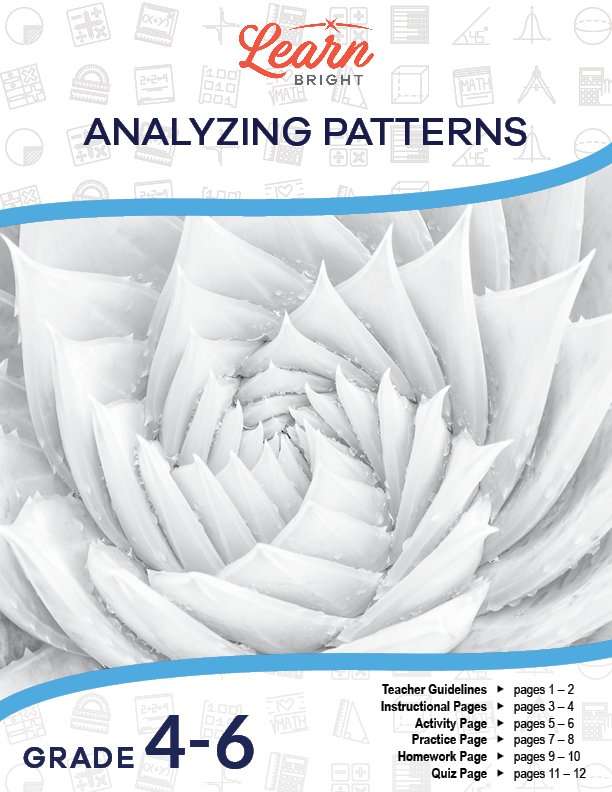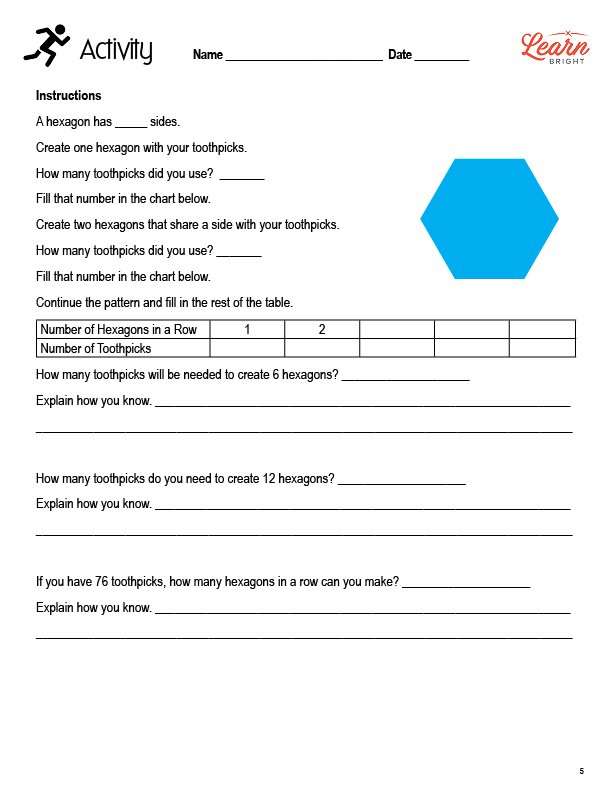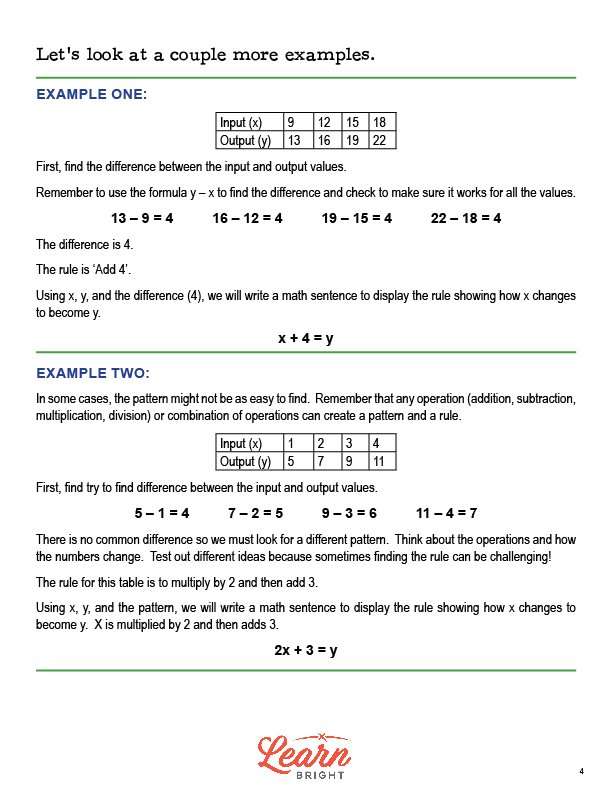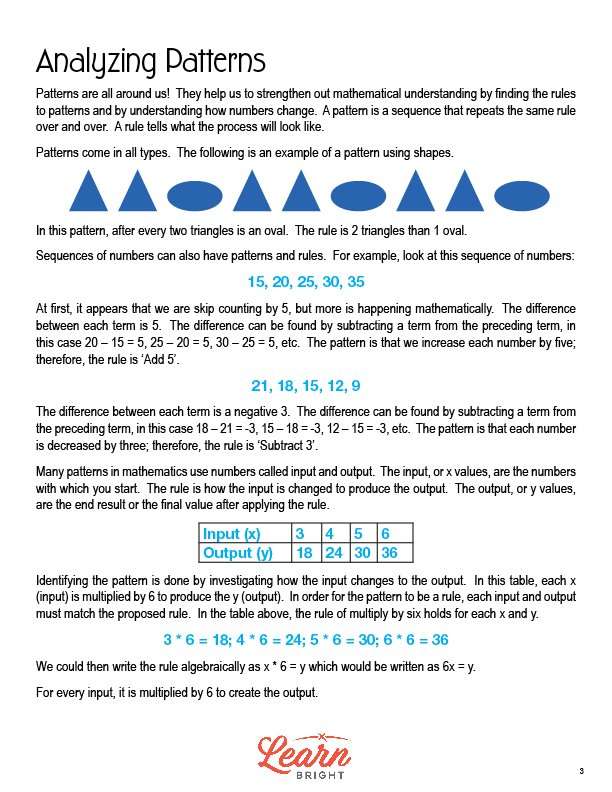Description
What our Analyzing Patterns lesson plan includes
Lesson Objectives and Overview: Analyzing Patterns provides examples of patterns using both numerical operations and shapes, discusses the vocabulary word input as the starting number, and the word output as the number found once the pattern rule is applied, and covers writing the pattern rule as an algebraic equation. At the end of the lesson, students will be able to analyze patterns and generate algebraic rules and find missing terms from a sequence. This lesson is for students in 4th grade, 5th grade, and 6th grade.
Classroom Procedure
Every lesson plan provides you with a classroom procedure page that outlines a step-by-step guide to follow. You do not have to follow the guide exactly. The guide helps you organize the lesson and details when to hand out worksheets. It also lists information in the blue box that you might find useful. You will find the lesson objectives, state standards, and number of class sessions the lesson should take to complete in this area. In addition, it describes the supplies you will need as well as what and how you need to prepare beforehand.
Options for Lesson
Included with this lesson is an “Options for Lesson” section that lists a number of suggestions for activities to add to the lesson or substitutions for the ones already in the lesson. One optional addition to this lesson is to have students use squares or triangles or other shapes to create more rows and patterns to explore. You can also put the shapes in other configurations—the hexagons can be in a honey comb pattern to increase difficulty level for students. You could have your students write stories about tables. Finally, you can have your students each write their own sequences to share and take turns guessing as a whole class.
Teacher Notes
The teacher notes page includes lines that you can use to add your own notes as you’re preparing for this lesson.
ANALYZING PATTERNS LESSON PLAN CONTENT PAGES
Analyzing Pattern
The Analyzing Patterns lesson plan includes two pages of content. You can see patterns all around you. Patterns help us sharpen our understanding of math through the processes of figuring out the rules for the patterns and learning to understand how numbers change. Patterns are sequences that repeat the same rule over and over again. Rules tell you what the process will look like.
We have many different types of patterns. The lesson shows a pattern using shapes where there are two triangles and then an oval. The rule is 2 triangles then 1 oval.
Number sequences can also have patterns or rules. For example, you might have the following sequence of numbers: 15, 20, 25, 30, 35. The difference between each term is 5. We can find the difference by subtracting a term from the preceding term. The pattern is to increase each number by five. The rule is Add 5.
Next, lesson includes another sequence where the difference between each term is negative 3. The pattern is to decrease each number by three, and the rule is Subtract 3.
Lots of mathematical patterns use numbers that we call input and output. You start with the input (x values). The rule is how you change the input to produce the output (y values). The output is the end result after you apply the rule.
Next, the lesson includes a table with input and output values. You can identify the pattern of these values by determining how the input changes to become the output. In the given table, you multiply each x value by 6 to produce the y values. In order for the pattern to be a rule, every input and output must match the pattern. Here, in the case of the table, they do!
The lesson closes with two examples that students can follow to better understand the lesson concepts. One example uses a pattern that’s easier to identify. The second example uses a pattern that’s harder to identify and shows students how to identify difficult patterns.
ANALYZING PATTERNS LESSON PLAN WORKSHEETS
The Analyzing Patterns lesson plan includes four worksheets: an activity worksheet, a practice worksheet, a homework assignment, and a quiz. You can refer to the guide on the classroom procedure page to determine when to hand out each worksheet.
HEXAGON ACTIVITY WORKSHEET
The activity worksheet asks students to create hexagons with toothpicks and answer questions about their shapes. This will create a pattern that they will then continue to fill in the rest of the table. Finally, they will answer a few final questions about the table.
SEQUENCE OF NUMBERS PRACTICE WORKSHEET
For the practice worksheet, students will find the rule for four sequences of numbers. They will then write the input or output values or the algebraic rule for each of the provided table. Finally, they will create their own input/output table and will write a story to explain their table.
ANALYZING PATTERNS MONEY HOMEWORK ASSIGNMENT
Like the practice worksheet, for the homework assignment, students will find the rule for two sequences of numbers. They will then write the input or output values or the algebraic rule for each of the provided table. Finally, they will create their own input/output table and will write a story to explain their table.
QUIZ
This lesson also includes a quiz that you can use to test students’ understanding of the lesson material. For the quiz, students will find the rule for the sequence of numbers. They will also write the input or output values or the algebraic rule for each of the provided table.
Worksheet Answer Keys
This lesson plan includes answer keys for the activity worksheet, the practice worksheet, the homework assignment, and a quiz. If you choose to administer the lesson pages to your students via PDF, you will need to save a new file that omits these pages. Otherwise, you can simply print out the applicable pages and keep these as reference for yourself when grading assignments.









